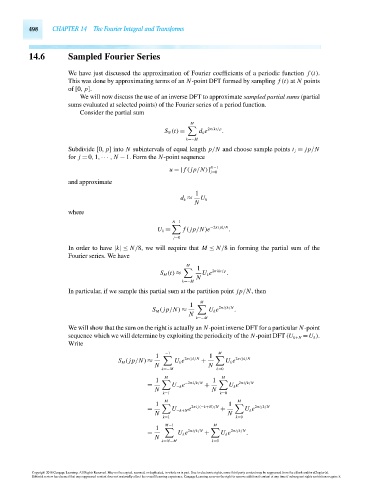Page 518 - Advanced engineering mathematics
P. 518
498 CHAPTER 14 The Fourier Integral and Transforms
14.6 Sampled Fourier Series
We have just discussed the approximation of Fourier coefficients of a periodic function f (t).
This was done by approximating terms of an N-point DFT formed by sampling f (t) at N points
of [0, p].
We will now discuss the use of an inverse DFT to approximate sampled partial sums (partial
sums evaluated at selected points) of the Fourier series of a period function.
Consider the partial sum
M
S N (t) = d k e 2πikt/p .
k=−M
Subdivide [0, p] into N subintervals of equal length p/N and choose sample points t j = jp/N
for j = 0,1,··· , N − 1. Form the N-point sequence
N−1
u =[ f ( jp/N)] j=0
and approximate
1
d k ≈ U k
N
where
N−1
U k = f ( jp/N)e −2πijk/N .
j=0
In order to have |k|≤ N/8, we will require that M ≤ N/8 in forming the partial sum of the
Fourier series. We have
M
1
2πikt/p
S M (t) ≈ U k e .
N
k=−M
In particular, if we sample this partial sum at the partition point jp/N, then
M
1
S M ( jp/N) ≈ U k e 2πijk/N .
N
k=−M
We will show that the sum on the right is actually an N-point inverse DFT for a particular N-point
sequence which we will determine by exploiting the periodicity of the N-point DFT (U k+N =U k ).
Write
−1 M
1 2πijk/N 1 2πijk/N
S M ( jp/N) ≈ U k e + U k e
N N
k=−M k=0
M
M
1 1
= U −k e −2πijk/N + U k e 2πijk/N
N N
k=1 k=0
M M
1 2πij(−k+N)/N 1 2πijk/N
= U −k+N e + U k e
N N
k=1 k=0
M−1 M
1
= U k e 2πijk/N + U k e 2πijk/N .
N
k=N−M k=0
Copyright 2010 Cengage Learning. All Rights Reserved. May not be copied, scanned, or duplicated, in whole or in part. Due to electronic rights, some third party content may be suppressed from the eBook and/or eChapter(s).
Editorial review has deemed that any suppressed content does not materially affect the overall learning experience. Cengage Learning reserves the right to remove additional content at any time if subsequent rights restrictions require it.
October 14, 2010 16:43 THM/NEIL Page-498 27410_14_ch14_p465-504

